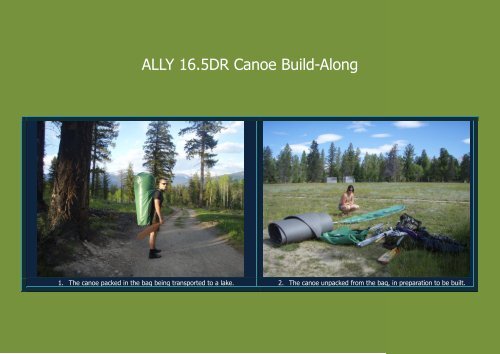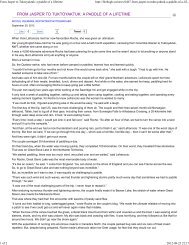ALLY 16.5DR Canoe Build-Along - Paddle The Waters
ALLY 16.5DR Canoe Build-Along - Paddle The Waters
ALLY 16.5DR Canoe Build-Along - Paddle The Waters
Create successful ePaper yourself
Turn your PDF publications into a flip-book with our unique Google optimized e-Paper software.
<strong>ALLY</strong> <strong>16.5DR</strong> <strong>Canoe</strong> <strong>Build</strong>-<strong>Along</strong><br />
1. <strong>The</strong> canoe packed in the bag being transported to a lake. 2. <strong>The</strong> canoe unpacked from the bag, in preparation to be built.
3. <strong>The</strong> skin is laid flat on its side and the gunwale rods are inserted. 4. <strong>The</strong> foam mat is then placed inside taking care to make sure the<br />
sides are level with each other otherwise it could perhaps make<br />
the boat lean slightly to one side (though I have had it poorly<br />
levelled and no difference was felt).<br />
5. <strong>The</strong> bow and stern stems are then added by connecting the double end of the stem to the gunwales.
6. <strong>The</strong> inner-chine rods are then put in the boat by attaching them to the lowest hooks on either stem.<br />
7. <strong>The</strong> outer-chine rods are then put in place attaching them to the middle hooks on either stem as before with the inner-chine rods. To help place<br />
them take hold of all 4 rods in the middle and push them down into the mat, then go round the sides to make sure they are roughly in place.
8. <strong>The</strong> keel rod is then inserted into the straight ends of each stem along the mat. <strong>The</strong> slight 'S' shape in the keel rod is normal at this stage and is<br />
flex which comes out once the other rods are in place and the ribs are being put in.<br />
9. Next, the waterline-chine rods are attached to the uppermost hook on either stem and positioned in the boat. As when installing the outer-chine<br />
rods, all 6 can be pulled up and pushed down together into the bottom of the boat to help position them. Now is also the time to make sure the<br />
mat is level, small adjustments are still able to be made. Go around the outside of the boat making sure the waterline-chine rods are even.
10. <strong>The</strong> second-widest cross-rib is located and put loosely in place to hold the gunwales apart, this helps to put in the widest cross-rib. As can be seen<br />
behind me, it helps to position the cross-ribs in order before beginning the building process. <strong>The</strong> plastic rib-connectors on the inner-chine rods<br />
should all be positioned facing upwards.<br />
<strong>The</strong> widest cross-rib is then put in. This is when you find out why a rubber mallet was provided with the Ally.<br />
11. Continue putting the cross-ribs in place building from the centre out towards bow and stern. Each cross-rib should be locked in place to the innerchine<br />
rods using the clips as can be seen here.
12. <strong>The</strong> seats are then constructed making sure the correct legs are used (they are all labelled) and installed. <strong>The</strong> height and angle of the seats can<br />
be adjusted to a certain degree and they can be moved back and forth depending where in the boat you wish to sit. <strong>The</strong>re are C-clips on the feet<br />
of the seats which lock them into place.
13. <strong>The</strong> Ally is now built. Below shows the splash-deck.
Optional<br />
1. <strong>The</strong> cord for the splash-deck is now fed through the loop attachments (these you must glue on yourself and do not come with the Ally, as the<br />
splash-deck does not) and tied at one end.<br />
2. <strong>The</strong> splash-deck is then attached by pulling the bungee cord fed through the attachments loops over the hooks along the side of the skirt. This<br />
pulls the skirt taught around the canoe. It is a great addition and one I would highly recommend if you are planning on white-water!<br />
<strong>The</strong> bow end is to the right and the bow paddlers skirt opening is closest to the centre opening for access to any equipment you may have inside. A cap<br />
is provided for the centre (like the top of a drum) and skirts attach to the stern and bow holes which can be removed (none are shown above).



